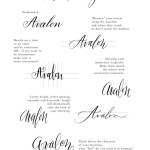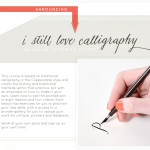 This is a bit if a controversial recommendation of a calligraphy book for most traditional calligraphers, but since a lot of you who are interested in this medium would prefer to develop your own contemporary calligraphy or modern lettering hand, than I think it would be a valuable addition to your studies. I am sure you have heard the adage that you must first learn the rules before you can break them? This book will assist you with the basics so you can then feel free to riff on your own. It will give you a ‘base’ + reference to begin to build your own lettering style. I have checked out many calligraphy books and watched numerous videos (I recommend Dr. Vitolo’s copperplate video’s and if you have an Ipad you can download his free book at Itunes), but Mastering Copperplate Calligraphy is the one that I keep coming back to. It is such a great reference because the author truly breaks down each letter to its very basics starting with the strokes you will need to know to create your initial letterforms. She has many examples of right and wrong ways for each letter and why a letter works or doesn’t (very helpful). I also like that she gives you many different variations/styles on a letter so you can work on the style you prefer most. There are guideline sheets in the book that you can copy and Winters even explains in depth how to create your own.
This is a bit if a controversial recommendation of a calligraphy book for most traditional calligraphers, but since a lot of you who are interested in this medium would prefer to develop your own contemporary calligraphy or modern lettering hand, than I think it would be a valuable addition to your studies. I am sure you have heard the adage that you must first learn the rules before you can break them? This book will assist you with the basics so you can then feel free to riff on your own. It will give you a ‘base’ + reference to begin to build your own lettering style. I have checked out many calligraphy books and watched numerous videos (I recommend Dr. Vitolo’s copperplate video’s and if you have an Ipad you can download his free book at Itunes), but Mastering Copperplate Calligraphy is the one that I keep coming back to. It is such a great reference because the author truly breaks down each letter to its very basics starting with the strokes you will need to know to create your initial letterforms. She has many examples of right and wrong ways for each letter and why a letter works or doesn’t (very helpful). I also like that she gives you many different variations/styles on a letter so you can work on the style you prefer most. There are guideline sheets in the book that you can copy and Winters even explains in depth how to create your own.
Many of you might be thinking, “peeshaw, I don’t want to learn traditional calligraphy, it’s not my thing”. I understand this sentiment (especially the peeshaw part), but I can tell you from my experience that even trying to practice a basic calligraphy alphabet will get you to your ultimate goal faster. You will learn things like spacing, baselines, heights of letters, how wide, etc. All of these tools will give you a better foundation to build your own alphabet one day. It may not look like there is any sort of structure to my own lettering samples I show you, but I do create all my samples utilizing a guideline sheet and starting the letters at the same baseline and adjusting the heights (the ascender, ie. the loop of an ‘h’ or the descender, ie the bottom loop of a ‘g’). I do take a lot of liberties and may make a rouge ‘u’ lower than it technically should be but I try to make sure it flows and works well with the word as a total. Of course, these are all things I have learned in my very limited time lettering and I am not trained as a traditional calligrapher so take this advice with a grain of salt; I am just sharing my personal experience. It has helped me a lot to hear that you are ‘drawing’ the letters rather than writing them. It makes sense to me and helps me feel better when I feel like I am taking too long creating a letterform. For those of you that are feeling completely overwhelmed right about now, my friend Maybelle (artist & calligrapher extraordinaire) suggests just using the nib + ink paired with your own handwriting to create a unique hand, she says that you may just be pleasantly surprised by the results; yes, even those of you like myself that have terrible cursive handwriting, she assures it can look quite charming!
Miss Tristan B. is the proprietress of Besotted Brand and the writer of this delightful blog. She practices her lettering almost every night and indeed looks like she works in a coal mine by the end of her long day.







sold! but then again, as of late, this blog sells me on many a/thing! xx
Perfect! And thank you. I really need this as I’ve been trying my hand at lettering and feel I need the foundation. Since I’m a leftie, I’ve always had trouble with traditional calligraphy but as an artist I know that a good foundation is key. I’ll check this out.
I love your calligraphy posts, and this is an excellent recommendation! I, too, have explored in-depth the many calligraphy resources available, and if I was only able to recommend a single resource, it would be this book. Your thoughts on the importance of understanding the foundations (even if you ultimately want to create non-traditional styles) are spot-on in my experience. Even the most non-traditional hand will be more aesthetically appealing when it accounts for the principles of good design.
Lol, well Rebecca this one won’t be too heavy on the pocket book, you can get very inexpensive used copies all over the place. Trust me it won’t matter new or used, because it will get worn out and ink dripped fairly swiftly.
Lori, it helps SO much. The guidelines help a lot too, if you put them under your paper that way you can use them without writing on them directly. I use a marker paper by Canson that has good see-thru properties but doesn’t bleed. A lot of the famous lettering artist right now are left-handed–Neither Snow, Paperfinger, there’s more I just can’t think of them, but I will one day devote a post to the leftie. I am both, as is my mom. When I was in school they tried to rid you of your left-handedness, lol. Times have changed!
Thank you for seconding (sp?) my opinion! I asked a professional calligrapher about this book and she kind of made a sucking in noise and a ‘tsk, tsk’ sound and tried to steer me away. I think for what most of us want to eventually get to with our lettering this is a fantastic book (and value). There’s a lot of info she goes over and the examples really helped me, although I must admit even her ‘wrong’ way of creating a letter looks beautiful to me. Your work work is beautiful Lisa!
Ok. I have dreamed of having better handwriting for ages. These posts are so exciting and get me so inspired. If I have never tried before, but I just think I might go for it!
Chelsea just try out the nib + ink with your own handwriting as Maybelle suggested you could have some very cool results!
All these wonderful resources make me want to start calligraphy too! I took Japanese calligraphy while living in a small town in Japan. But it was with a brush and though beautiful, I discovered that being lefty (I’m a bit ambi as well but can write only with my left; I play sports with my right) is detrimental to Japanese calligraphy because they still convert students to right-handedness which means that all the lessons are taught with that in mind. I refused to switch to my right hand and had to contort my hand and body to get the strokes to come out looking barely passable…
Got this book a few weeks ago! You recommending this gave me the assurance that I bought the right book :) it is indeed very helpful especially for beginners like me. I also took note of your suggested nibs and so far, Nikko works for me the best (I’ve tried using Hunt 22 and Zebra).
Oh, I love the brush calligraphy. I have done a lot of brush abstracts using Sumi and the Japanese calligraphy brush, it is very zen. You should just use the tools if you still have them to just play. There’s a wonderful lettering artist in Sweden that uses the brush + sumi ink and her own handwriting to create really interesting artworks.
Bituin, so excited that you have given this a go! Nikko is a beautiful nib, so smooth it will give you a lot of confidence, more so than starting with a bouncy nib that catches a lot which can be so frustrating for a newbie. I need to start a lettering group on Pinterest so I can see everyone’s work + progress!
Agree on the Pinterest group, Tristan! It’ll also be a good motivation for us beginners to practice regularly :)
Let me mull over the best way to do it, I would love to!
My mom taught calligraphy but never showed me…I’m going to talk to her about that…would love to learn!
Oh, that’s a shame! My mom never taught me her native language so there’s that. If your mom is a traditional calligrapher she probably won’t like this book, most traditional calligraphers don’t. Susan, it may be tough to pick-up calligraphy now with baby twins! It’s messy, but perhaps late at night when they are asleep? It’s very, very relaxing, it’s a great way to wind down at the end of a long day and there’s such a sense of accomplishment when you lok book at your practice and see that you have actually improved and you will with each session, it’s amazing!
Excellent recommendation Tristan, I think I’ll save this for later after I have mastered a few basics!
Just discovered your blog and love it! I’ve recently started getting back into hand lettering and was looking for a book on calligraphy. Thanks for the book recommendation and look forward to reading more on your blog!
Just came upon your website and blog and I am so glad I did! I learned calligraphy eons ago in school, the old-fashioned style, which is still the classic, but have been teaching myself modern calligraphy, which I love. I invested in the same Copperplate book you recommend months ago. You are absolutely right: it helps a lot to have the fundamentals of the copperplate alphabet before tackling the modern style. Glad to see I was on the right track!
Susan I am always happy to read another person has decided to take up the pen and nib! Enjoy yourself, we have tons of professional modern calligrapher interviews that are such a delight to read!
I found the best book on calligraphy “The Lettering and Modern Calligraphy” book https://www.onlinebooksreview.com/articles/best-calligraphy-book#1948209004. If you are an absolute beginner with or without any decent artistic talent then this comprehensive guide will suit you the most to learn Calligraphy. It contains basic foundation with lots of visuals, built-in structure, and repetition of topics in order to get the feel of how letters are created. It is easy to follow and offers a great variety of fonts to practice.